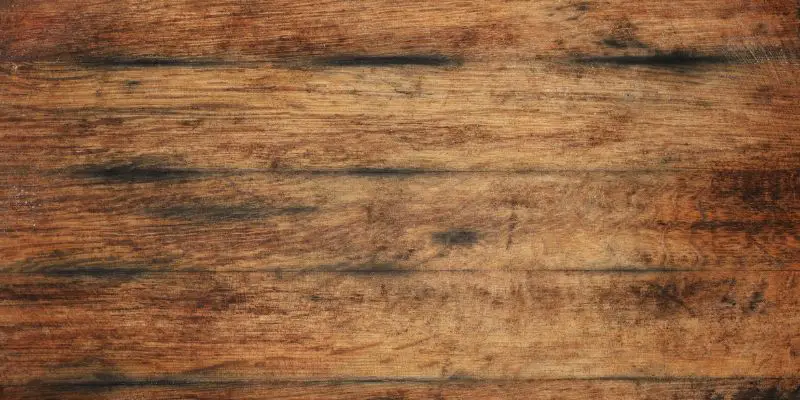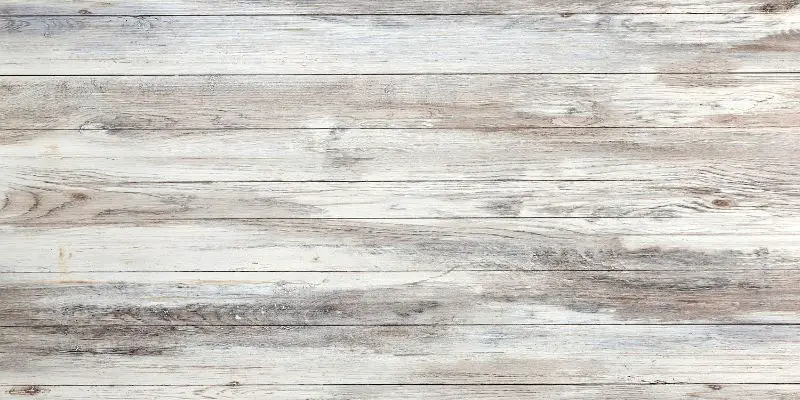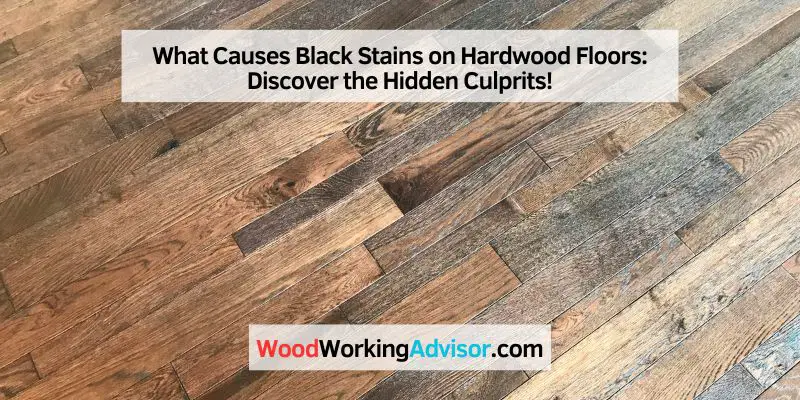Black stains on hardwood floors are caused by water damage and prolonged exposure to moisture. These stains occur when moisture seeps into the wood and reacts with tannins present in the hardwood, resulting in dark discoloration.
To prevent black stains on hardwood floors, it is important to promptly clean up any spills or leaks, maintain proper humidity levels in the home, and ensure adequate ventilation. Regularly inspecting the flooring for signs of water damage and taking necessary precautions can help maintain the beauty and integrity of hardwood floors.
Common Causes Of Black Stains On Hardwood Floors
Black stains on hardwood floors can be a cause for concern as they not only affect the appearance of your beautiful flooring but may also indicate underlying damage. Understanding the common causes of these black stains can help you identify and address the issue promptly. From water damage to mold and mildew growth, various factors can contribute to the development of these unsightly stains. In this article, we will explore each of these key causes in detail and provide insight into how to prevent and treat them effectively.
Water Damage
Water damage is a leading cause of black stains on hardwood floors. When excess moisture penetrates the wood, it can lead to the growth of mold, mildew, and other fungi. Additionally, prolonged exposure to water can cause the wood to rot, further exacerbating the problem. Common sources of water damage include leaks from plumbing fixtures, flooding, and spills left unattended. It is crucial to address water damage promptly to prevent the development of black stains and protect the integrity of your hardwood flooring.
Mold And Mildew Growth
Mold and mildew are another common culprits behind black stains on hardwood floors. These types of fungi thrive in damp and dark environments, making your hardwood flooring susceptible if moisture is present. Once mold and mildew establish a foothold, they can spread rapidly and cause extensive damage. Besides the appearance of black stains, mold, and mildew can also lead to a musty odor and potential health risks. Regularly inspecting and maintaining proper ventilation in areas prone to moisture can help prevent mold and mildew growth, thus preserving the pristine condition of your hardwood floors.

Identifying Water Damage As A Culprit
When it comes to the mysterious appearance of black stains on hardwood floors, one of the potential culprits may be water damage. Understanding the effects of water on wood and being able to recognize the signs of water damage on hardwood floors is crucial in resolving this issue efficiently. If left unchecked, water damage can lead to further problems, including the growth of mold and rot, which can compromise the structural integrity of your hardwood floors. In this section, we’ll delve into the effects of water on wood and provide you with useful tips on how to identify water damage on your hardwood floors.
Understanding The Effects Of Water On Wood
Wood is a porous material that readily absorbs moisture. When water comes into contact with hardwood floors, it can penetrate the surface and seep into the wood fibers. This can result in a variety of negative effects on the wood itself, including:
- Expansion and contraction: As wood absorbs moisture, it expands. When the moisture evaporates, the wood contracts. This continuous cycle of expansion and contraction can lead to warping, cracking, and buckling of hardwood floors.
- Color changes: Water can cause the natural color of hardwood floors to darken or develop black stains. This discoloration is often a result of tannins in the wood reacting with the water.
- Mold and mildew growth: Excess moisture provides a favorable environment for mold and mildew to grow. These microorganisms can thrive in the dark and damp areas beneath hardwood floors, leading to unpleasant odors and potential health hazards.
Signs Of Water Damage On Hardwood Floors
Identifying water damage on hardwood floors requires careful observation. Here are some common signs to watch out for:
- Discoloration: Observe if there are any dark or black stains on the surface of your hardwood floors. These stains are often an indication of water damage.
- Warping or buckling: Check if your hardwood planks are no longer flat and have started to warp or buckle. This is a clear sign that moisture has affected the wood’s structure.
- Soft or spongy areas: Gently press down on different areas of your hardwood floors. If you notice any soft or spongy spots, it could indicate water damage and weakened wood.
- Musty odor: An unpleasant, musty smell could indicate the presence of mold or mildew beneath your hardwood floors. This odor is often accompanied by visible signs of water damage.
If you notice any of these signs, it is crucial to take immediate action to mitigate the water damage and prevent further harm to your hardwood floors. Ignoring the issue can result in costly repairs or even the need for complete floor replacement.
Dealing With Mold And Mildew Growth
Mold and mildew are common culprits when it comes to black stains on hardwood floors. Dealing with mold and mildew growth is crucial to maintaining the integrity and appearance of your flooring. Understanding the impact of mold and mildew and the preventive measures and remediation methods is essential for effective floor care.
Impact Of Mold And Mildew On Hardwood Floors
Mold and mildew can wreak havoc on hardwood floors. Excessive moisture can lead to the growth of mold and mildew, causing unsightly black stains and compromising the structural integrity of the wood.
Additionally, mold and mildew can contribute to poor indoor air quality and pose health risks to inhabitants. The longer these issues persist, the greater the damage and potential health hazards.
Preventive Measures And Remediation
Preventing mold and mildew growth is key to preserving the condition of your hardwood floors. Maintaining optimal humidity levels, promptly addressing water damage, and ensuring proper ventilation are essential preventive measures.
If mold and mildew have already taken hold, swift remediation is crucial. This may involve thoroughly cleaning and drying the affected area, removing any damaged flooring, and addressing the root cause of moisture buildup.
Exploring Other Culprits For Black Stains
Chemical Reactions And Stains
Chemical reactions can also be a culprit when it comes to black stains on hardwood floors. Certain cleaning products or spills containing strong chemicals can react with the wood’s natural tannins, causing them to darken and leave behind unsightly stains. These chemical reactions are often difficult to prevent, as accidents happen and spills are common in everyday life.
It’s important to use gentle and pH-neutral cleaners specifically designed for hardwood floors to minimize the risk of chemical reactions. Additionally, wiping up spills immediately can help prevent the chemicals from penetrating the wood and causing stains.
Insect Infestation
Insect infestation is another potential cause of black stains on hardwood floors. Wood-boring insects like beetles or termites can burrow into the wood, leaving behind sawdust and excrement that can darken the surface. Over time, these infestations can lead to significant structural damage, so it’s important to address any signs of insect activity promptly.
Regular inspections of your hardwood floors can help identify early stages of insect infestation. If you notice tiny holes, sawdust piles, or unusual black stains, it’s best to consult a professional pest control expert to assess the situation and recommend appropriate treatment.
By addressing chemical reactions and keeping an eye out for insect infestations, you can take proactive steps to prevent black stains on your hardwood floors. Remember to use suitable cleaning products and consider professional pest control assistance when needed to preserve the beauty and longevity of your hardwood floors.
Effective Maintenance And Prevention Techniques
When it comes to maintaining and preventing black stains on hardwood floors, effective maintenance techniques play a crucial role. Regular cleaning and inspection, as well as proper humidity control, are key in keeping your hardwood floors in pristine condition. By following these simple yet important maintenance and prevention techniques, you can ensure that your hardwood floors remain free from black stains and retain their natural beauty for years to come.
Regular Cleaning And Inspection
Regular cleaning and inspection are essential in preventing black stains on hardwood floors. Cleaning your floors on a regular basis removes dirt, dust, and other debris that can cause discoloration over time. Additionally, inspecting your floors allows you to identify and address any potential issues before they worsen.
- Use a soft bristle broom or vacuum with a hardwood floor attachment to remove loose dirt and debris from the surface.
- Wipe the floor with a microfiber mop or cloth dampened with a pH-neutral Hardwood Floor Cleaner to remove embedded dirt and grime.
- Avoid using excessive water or harsh cleaning products, as they can damage the wood.
- Regularly check for any signs of moisture, leaks, or spills that could lead to black stains.
- Address any spills or moisture promptly by drying the affected area thoroughly.
Proper Humidity Control
Proper humidity control is vital to maintaining the condition of hardwood floors. Fluctuations in humidity levels can cause wood to expand or contract, leading to gaps or cupping in the floorboards. It can also create a favorable environment for mold and mildew growth, which can result in black stains. Follow these guidelines to ensure proper humidity control:
- Keep the humidity level in your home between 40% to 50% using a humidifier or dehumidifier, depending on the season.
- Avoid extreme humidity levels by keeping the temperature in your home consistent.
- Place area rugs or mats in high-traffic areas to minimize direct exposure to moisture.
- Use protective pads on furniture legs to prevent scratching and minimize moisture buildup.
- Ensure proper ventilation in areas prone to moisture, such as bathrooms and kitchens.

Frequently Asked Questions Of What Causes Black Stains On Hardwood Floors
How Do You Remove Black Stains From Hardwood Floors?
To remove black stains from hardwood floors, mix vinegar and water, then scrub the affected area. Alternatively, use hydrogen peroxide or baking soda paste and leave it on the stain for a few hours before wiping it off. Sand and refinish the area if the stain persists.
Why Is My Wood Floor Turning Black?
Wood floors may turn black due to water damage, mold or mildew growth, or exposure to high humidity. It is important to address the underlying issue, such as fixing leaks or improving ventilation, to prevent further damage. Regular cleaning and maintenance can help preserve the beauty of your wood floor.
How Do You Remove Black Water Stains From Hardwood Floors?
To remove black water stains from hardwood floors, mix equal parts vinegar and water, apply the mixture to the stain, and let it sit for a few minutes. Gently scrub the area with a cloth or soft brush, then wipe it clean.
Repeat if necessary.
How Do You Remove Damp Black Stains From Wood Floors?
To remove damp black stains from wood floors, mix equal parts vinegar and water. Scrub the stained areas gently and wipe with a clean cloth. Apply a wood cleaner and polish the floors. Dry thoroughly. Repeat if necessary. Avoid using excessive water to prevent damage.
Conclusion
Understanding the root causes of black stains on hardwood floors is crucial. By addressing moisture, mold, or chemical reactions, you can prevent and treat these stains effectively. Regular maintenance and prompt action can preserve the beauty of your hardwood floors for years to come.
Keep them clean and dry to avoid unsightly blemishes.


